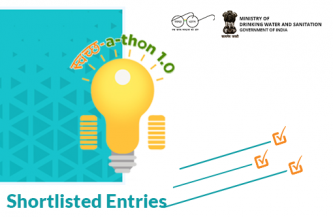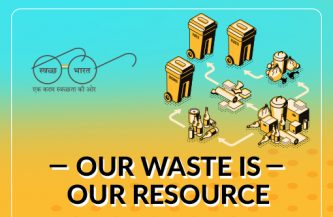Transformative change under the Swachh Bharat Mission

Over the last five years, the people of India have rallied behind the clarion call of the Prime Minister and have collectively changed habits that they had held on to for centuries. India has witnessed a sanitation revolution – a movement, of the people, by the people and for the people. This massive people’s movement is arguably the largest behavior change movement of all time.
The Swachh Bharat Mission (SBM) has become a leading example for participatory development. It has shown that transformative change can be achieved if each and every individual contributes to and becomes a part of the revolution. From recruiting lakhs of swachhagrahis to spread the message of sanitation, to helping thousands of rani mistris break gender stereotypes and construct toilets, to having the Swachh Bharat logo on every new currency note in the country – SBM went far beyond the mandate of just one Ministry.
SBM endeavored to practice what Richard Thaler, the 2017 Nobel Prize winning economist, preached on behavioural economics and, in particular, on the art of ‘nudging’ – how small interventions help individuals or communities change deep-seated behaviours. Over the last five years SBM has been nudging rural communities in India to change their habit of open defecation by using household toilets. These gentle nudges have come through with massive returns.
SBM has had a positive impact on the life, health, wealth and dignity of rural communities. Amplifying these benefits is SBM’s impact on the market economy and, in particular, on job creation, which is significant by itself. The massive improvement in India’s sanitation coverage has resulted in direct employment opportunities for masons, labourers and industries involved in supplying sanitaryware, and indirect opportunities for several associated sectors. One toilet needs on an average one mason and two labourers to work for three days, meaning the construction of one toilet requires an average of nine person-days of work. For the construction of 10 crore toilets (progress as of October 2019) under SBM-Grameen, an estimated 90 crore person-days of employment have been generated. Assuming that one person-year of work comprises 200 working days, these total to well over 45 lakh person-years of work!
SBM has contributed significantly to the country’s productivity. UNICEF had earlier estimated that nearly 38 per cent of India’s children under five were physically and cognitively stunted, primarily because of the lack of sanitation. The inability of such a large portion of our future workforce to reach their full productive capacity poses a serious threat to our biggest strength – our demographic dividend. SBM’s impact on reducing malnutrition had been studied through the Bill & Melinda Gates Foundation health impact study which found that in Open Defecation Free (ODF) areas, there were 32 per cent fewer cases of diarrhoea among children, 15 per cent fewer cases of stunting, and 32 per cent fewer cases of women with below normal BMI. Better nutrition and better health for women and children directly contributes to higher school attendance and improved learning outcomes.
What the last five years have proved beyond doubt is the importance of collective action when it comes to public health. The rapid improvements in sanitation across the country have had a positive spin-off on various other sectors of development as well. The effectiveness of other flagship programmes of the Government like Integrated Child Development Services, Skill India, Beti Bachao Beti Padhao, Make in India, among others, has increased manifold simply by improving the nutrition intake capacity of children and improving overall productivity. Ensuring that the SBM bases itself as everyone’s business, the Prime Minister himself set sanitation at the centre of the national discourse, comfortably making its way into everyone’s consciousness. Compared to pre-2014, every citizen of the country is much more aware today about the once shunned topic of open defecation and toilets. The 2019 study by BMGF on the assessment of SBM’s behaviour change communication gave us a number to put that in context: since 2014, the average rural Indian was reached by SBM messaging over 3,000 times. That’s almost twice a day every day for four and a half years!
As implementers, we have to get the right tools in place in a timely manner. For the most part, the idea is to achieve and sustain holistic sanitation and create institutional memory to take sanitation into account for years to come. Having made incredible progress under the SBM, the Mission is now focusing heavily on its sustainability and ensuring that no one is left behind, as it actively moves to the next level – ODF Plus.
ODF Plus is the broader goal of overall cleanliness in India’s villages. The key factors in becoming ODF Plus are ODF-Sustainability, Solid Waste Management (biodegradable and plastic) and Liquid Waste Management (Grey Water and Fecal Sludge Management), as required. A village would be considered ODF Plus if it continues to sustain its ODF status and safely manages its solid and liquid waste. We are committed to ensuring that every village moves from ODF to ODF Plus over the next few years.
To reorient and institutionalize the capacities of members of panchayati raj institutions and swachhagrahis towards ODF Plus, a pool of skilled field trainers are being created in every district. These trainers will further build the capabilities of around 11 lakh village-level functionaries (beginning with 2.5 lakh sarpanches, 2.5 lakh panchayat secretaries, about 6 lakh swachhagrahis and masons) with adequate information and knowledge on keeping the sanitation momentum soaring ahead and moving from ODF to ODF Plus.
One thing is for sure – the change is real, and the change is here. The Government of India has taken a momentous step towards an integrated take on water resources management and sanitation in the country by creating a new Ministry – the Ministry of Jal Shakti. With the merging of the Ministry of Water Resources, River Development and Ganga Rejuvenation with and the Ministry of Drinking Water and Sanitation, the stage is set for an integrated approach to managing water more efficiently, preventing its wastage and maximizing its utility. This Ministry is already working towards bringing piped water supply to all households by 2024, with mandatory source sustainability and grey water reuse and recharge measures for an integrated and holistic approach to water and sanitation. This is being done through the Jal Jeevan Mission, an ambitious programme designed along the lines of the SBM as a jan andolan, a people’s movement, with integrated water demand and supply management at the grassroots.
On 15 August 2014, we witnessed a defining moment in India’s modern history – a tipping point which led the country to a sanitation revolution, and on 15 August 2019, we witnessed one for water. The SBM is a shot in the arm for the world striving to achieve the Sustainable Development Goals. It is a fascinating story of political leadership like no other, harnessing the power of the people. It is a story of what is possible how the people of a nation, inspired by a leader, can come together and achieve the seemingly unachievable.
(The author is Shri Parameswaran Iyer, Secretary, Ministry of Drinking Water and Sanitation)





